For my semester colleagues and me, it is time to spread our wings to perform an internship at another university department, an agency or a company, in Germany or abroad. This first part will provide impressions from my studies on wildlife monitoring in Denmark and Stefan’s AMEO on effects of pesticides in Romania.
Denmark, Risø – wildlife monitoring
My AMEO course, which is in cooperation with the Department of Bioscience (BIOS) of the Århus University in Roskilde, Denmark, focuses on investigating geographical and temporal variation in pollution, ecology and health in wildlife. For avian top predators like the white-tailed eagle (Haliaeetus albicilla), I measure mercury (tHg) levels and stable isotope ratios, using nestling feathers from Danish, German, Finnish and Estonian populations. This matrix can provide more information about pollution levels than one might expect: it can integrate the exposure to the pollutant as well as its dietary source by the analysis of Hg and stable carbon and nitrogen isotopes. In fact, 5 mg of feather material is often sufficient to perform these analyses.

Non-invasive sampling method: use of feathers for tHg and stable isotopes measurements (pictures by I. Eulaers and K. Lühmann)
A wide range of disciplines, such as ecotoxicology, veterinary science, ecology and environmental chemistry, can be found at BIOS. The study areas focus mostly on the Arctic, especially Greenland, as well as the Baltic. A variety of species, such as polar bear (Ursus maritimus), seals, whales and birds of prey are being investigated. Moreover, in the light of AMAP (Arctic Monitoring and Assessment Programme), even human exposure and risk assessment are being performed here. For further information about the research, see http://bios.au.dk/en/research/. Not only the field of study is attractive, the location next to the Roskildefjord offers a unique opportunity for ecotoxicology students, for instance to have a swim after a hard field or lab day 🙂
Romania, Cluj – Freshwater Ecotoxicology
In case you wonder why to travel from Landau, which is surrounded by agricultural landscape, all the way to Romania to conduct a study on the net effects of pesticides, here is the reason: in contrast to other European countries it is possible to find reference sites in Romania, which are without any history of pesticide application. Thus it is possible to avoid the co-occurence of natural effects and pesticide effects in this field study. The aim of this joint project with Babeș-Bolyai University is to study the effects of a pesticide gradient on freshwater and terrestrial ecosystems. The study area includes 19 sampling sites in a radius of 130 km from Cluj. For the sites similar environmental conditions are assumed, because the nutrient and sediment flux are comparable. For more details about the project see our earlier blog post.
The internship includes both, field as well as laboratory work. The filed work includes measuring surface runoff into freshwater ecosystems next to fields as well as these systems’ physiochemical parameters, the maintenance of passive samplers and the sampling of macrozoobenthos. In the lab, solid phase extractions of the water samples are conducted. The AMEO offers insights into a field study of large scale and extraordinary relevance.
What’s coming next? Below you see a map of the current AMEO locations. So stay tuned for the upcoming AMEO posts!


